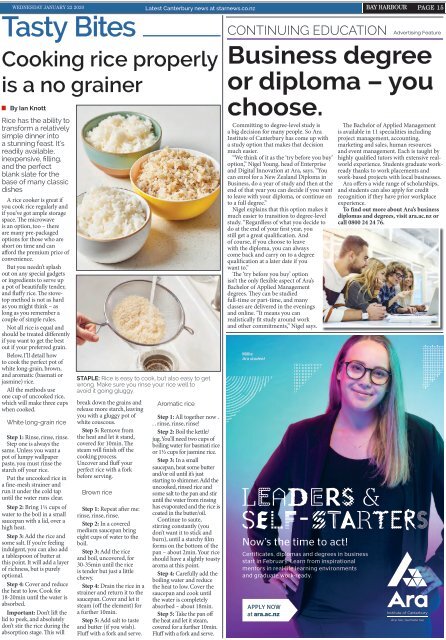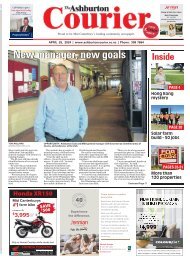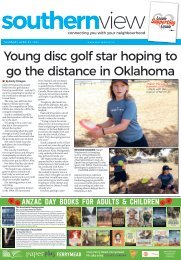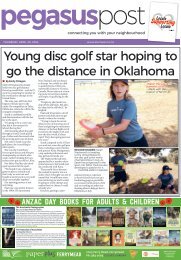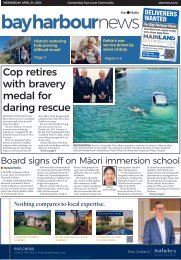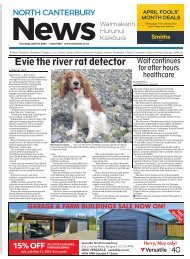Bay Harbour: January 22, 2020
You also want an ePaper? Increase the reach of your titles
YUMPU automatically turns print PDFs into web optimized ePapers that Google loves.
Wednesday <strong>January</strong> <strong>22</strong> <strong>2020</strong><br />
2 [Edition datE]<br />
Tasty Bites<br />
Latest Canterbury news at starnews.co.nz<br />
BAY HARBOUR<br />
CONTINUING EDUCATION<br />
PAGE 15<br />
Cooking rice properly<br />
is a no grainer<br />
By Ian Knott<br />
Rice has the ability to<br />
transform a relatively<br />
simple dinner into<br />
a stunning feast. It’s<br />
readily available,<br />
inexpensive, filling,<br />
and the perfect<br />
blank slate for the<br />
base of many classic<br />
dishes<br />
A rice cooker is great if<br />
you cook rice regularly and<br />
if you’ve got ample storage<br />
space. The microwave<br />
is an option, too – there<br />
are many pre-packaged<br />
options for those who are<br />
short on time and can<br />
afford the premium price of<br />
convenience.<br />
But you needn’t splash<br />
out on any special gadgets<br />
or ingredients to serve up<br />
a pot of beautifully tender,<br />
and fluffy rice. The stovetop<br />
method is not as hard<br />
as you might think – as<br />
long as you remember a<br />
couple of simple rules.<br />
Not all rice is equal and<br />
should be treated differently<br />
if you want to get the best<br />
out if your preferred grain.<br />
Below, I’ll detail how<br />
to cook the perfect pot of<br />
white long-grain, brown,<br />
and aromatic (basmati or<br />
jasmine) rice.<br />
All the methods use<br />
one cup of uncooked rice,<br />
which will make three cups<br />
when cooked.<br />
White long-grain rice<br />
Step 1: Rinse, rinse, rinse.<br />
Step one is always the<br />
same. Unless you want a<br />
pot of lumpy wallpaper<br />
paste, you must rinse the<br />
starch off your rice.<br />
Put the uncooked rice in<br />
a fine-mesh strainer and<br />
run it under the cold tap<br />
until the water runs clear.<br />
Step 2: Bring 1½ cups of<br />
water to the boil in a small<br />
saucepan with a lid, over a<br />
high heat.<br />
Step 3: Add the rice and<br />
some salt. If you’re feeling<br />
indulgent, you can also add<br />
a tablespoon of butter at<br />
this point. It will add a layer<br />
of richness, but is purely<br />
optional.<br />
Step 4: Cover and reduce<br />
the heat to low. Cook for<br />
18-20min until the water is<br />
absorbed.<br />
Important: Don’t lift the<br />
lid to peek, and absolutely<br />
don’t stir the rice during the<br />
absorption stage. This will<br />
STAPLE: Rice is easy to cook, but also easy to get<br />
wrong. Make sure you rinse your rice well to<br />
avoid it going gluggy.<br />
break down the grains and<br />
release more starch, leaving<br />
you with a gluggy pot of<br />
white couscous.<br />
Step 5: Remove from<br />
the heat and let it stand,<br />
covered for 10min. The<br />
steam will finish off the<br />
cooking process.<br />
Uncover and fluff your<br />
perfect rice with a fork<br />
before serving.<br />
Brown rice<br />
Step 1: Repeat after me:<br />
rinse, rinse, rinse.<br />
Step 2: In a covered<br />
medium saucepan bring<br />
eight cups of water to the<br />
boil.<br />
Step 3: Add the rice<br />
and boil, uncovered, for<br />
30-35min until the rice<br />
is tender but just a little<br />
chewy.<br />
Step 4: Drain the rice in a<br />
strainer and return it to the<br />
saucepan. Cover and let it<br />
steam (off the element) for<br />
a further 10min.<br />
Step 5: Add salt to taste<br />
and butter (if you wish).<br />
Fluff with a fork and serve.<br />
Aromatic rice<br />
Step 1: All together now .<br />
. . rinse, rinse, rinse!<br />
Step 2: Boil the kettle/<br />
jug. You’ll need two cups of<br />
boiling water for basmati rice<br />
or 1½ cups for jasmine rice.<br />
Step 3: In a small<br />
saucepan, heat some butter<br />
and/or oil until it’s just<br />
starting to shimmer. Add the<br />
uncooked, rinsed rice and<br />
some salt to the pan and stir<br />
until the water from rinsing<br />
has evaporated and the rice is<br />
coated in the butter/oil.<br />
Continue to saute,<br />
stirring constantly (you<br />
don’t want it to stick and<br />
burn), until a starchy film<br />
forms on the bottom of the<br />
pan – about 2min. Your rice<br />
should have a slightly toasty<br />
aroma at this point.<br />
Step 4: Carefully add the<br />
boiling water and reduce<br />
the heat to low. Cover the<br />
saucepan and cook until<br />
the water is completely<br />
absorbed – about 18min.<br />
Step 5: Take the pan off<br />
the heat and let it steam,<br />
covered for a further 10min.<br />
Fluff with a fork and serve.<br />
Business degree<br />
or diploma – you<br />
choose.<br />
Committing to degree-level study is<br />
a big decision for many people. So Ara<br />
Institute of Canterbury has come up with<br />
a study option that makes that decision<br />
much easier.<br />
“We think of it as the ‘try before you buy’<br />
option,” Nigel Young, head of Enterprise<br />
and Digital Innovation at Ara, says. “You<br />
can enrol for a New Zealand Diploma in<br />
Business, do a year of study and then at the<br />
end of that year you can decide if you want<br />
to leave with your diploma, or continue on<br />
to a full degree.”<br />
Nigel explains that this option makes it<br />
much easier to transition to degree-level<br />
study. “Regardless of what you decide to<br />
do at the end of your first year, you<br />
still get a great qualification. And<br />
of course, if you choose to leave<br />
with the diploma, you can always<br />
come back and carry on to a degree<br />
qualification at a later date if you<br />
want to.”<br />
The ‘try before you buy’ option<br />
isn’t the only flexible aspect of Ara’s<br />
Bachelor of Applied Management<br />
degrees. They can be studied<br />
full-time or part-time, and many<br />
classes are delivered in the evenings<br />
and online. “It means you can<br />
realistically fit study around work<br />
and other commitments,” Nigel says.<br />
The Bachelor of Applied Management<br />
is available in 11 specialities including<br />
project management, accounting,<br />
marketing and sales, human resources<br />
and event management. Each is taught by<br />
highly qualified tutors with extensive realworld<br />
experience. Students graduate workready<br />
thanks to work placements and<br />
work-based projects with local businesses.<br />
Ara offers a wide range of scholarships,<br />
and students can also apply for credit<br />
recognition if they have prior workplace<br />
experience.<br />
To find out more about Ara’s business<br />
diplomas and degrees, visit ara.ac.nz or<br />
call 0800 24 24 76.


